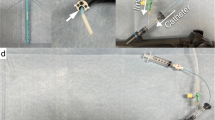Abstract
Purpose
Massive hemorrhages pose a significant problem in intraventricular endoscopic surgeries. These hemorrhages have the potential to cause mortality and morbidity, particularly in excisional surgeries. Often, the bleeding can be controlled only by cauterization and liquid irrigation, due to the incongruity of the use of antihemorrhagic agents in the fluid. The final option to stop the massive bleeding is the dry-field maneuver. In this study, the effects and clinical results of the dry-field maneuver in bleeding control of a massive bleeding were investigated.
Methods
Dry-field maneuver was retrospectively studied in a patient population that had massive bleeding during intraventricular endoscopic procedures.
Results
Dry-field maneuver was used in seven patients. Four of these patients underwent some excisional surgery. The other two patients were operated for an endoscopic third ventriculostomy and one for intraventricular hemorrhage evacuation. It was observed that the hemorrhage in patients stopped rapidly after the dry-field maneuver. Moreover, there was no need for an antihemorrhagic material.
Conclusion
Dry-field maneuver is an option for providing hemostasis, particularly, for a massive hemorrhage. It also has the potential to be used in elective surgeries because it improves the visual quality.


Similar content being viewed by others
References
Schroeder HW, Niendorf WR, Gaab MR (2002) Complications of endoscopic third ventriculostomy. J Neurosurg 96:1032–1040
Di Rocco C, Massimi L, Tamburrini G (2006) Shunts vs endoscopic third ventriculostomy in infants: are there different types and/or rates of complications? A review. Childs Nerv Syst 22:1573–1589
Abtin K, Thompson BG, Walker ML (1998) Basilar artery perforation as a complication of endoscopic third ventriculostomy. Pediatr Neurosurg, Switzerland, pp 35–41
Cinalli G, Salazar C, Mallucci C, Yada JZ, Zerah M, Sainte-Rose C (1998) The role of endoscopic third ventriculostomy in the management of shunt malfunction. Neurosurgery 43:1323–1327 discussion 1327-1329
McLaughlin MR, Wahlig JB, Kaufmann AM, Albright AL (1997) Traumatic basilar aneurysm after endoscopic third ventriculostomy: case report. Neurosurgery 41:1400–1403 discussion 1403-1404
Tieu BH, Holcomb JB, Schreiber MA (2007) Coagulopathy: its pathophysiology and treatment in the injured patient. World J Surg 31:1055–1064
Fukushima T, Ishijima B, Hirakawa K, Nakamura N, Sano K (1973) Ventriculofiberscope: a new technique for endoscopic diagnosis and operation. Technical note. J Neurosurg 38:251–256
Fukushima T (1978) Endoscopic biopsy of intraventricular tumors with the use of a ventriculofiberscope. Neurosurgery 2:110–113
Arakawa Y, Kang Y, Murata D, Fujimoto K, Miyamoto S (2013) Endoscopic surgery for intraventricular and paraventricular tumors. Neuro-Oncology 15:218–218
Turhan T, Aydin O, Ersahin Y (2012) Neuroendoscopic surgery in empty ventricular system under continuous gas infusion experimental study of pressure changes and complications. Childs Nerv Syst 28:73–77
Charalampaki P, Filippi R, Welschehold S, Conrad J, Perneczky A (2005) Tumors of the lateral and third ventricle: removal under endoscope-assisted keyhole conditions. Neurosurgery 57:302–311 discussion 302-311
Charalampaki P, Filippi R, Welschehold S, Perneczky A (2006) Endoscope-assisted removal of colloid cysts of the third ventricle. Neurosurg Rev 29:72–79
Acknowledgments
This work was presented as a verbal statement at the 42nd ISPN meeting in Rio de Janeiro in 2014. The other academician who worked on this study was Prof. Dr. Yusuf Erşahin who unfortunately passed away in the same year. I remember him with respect.
Author information
Authors and Affiliations
Corresponding author
Ethics declarations
Conflict of interest
The corresponding author states that there is no conflict of interest.
Electronic supplementary material
(WMV 118623 kb)
Rights and permissions
About this article
Cite this article
Turhan, T. Dry-field maneuver for controlling the massive intraventricular bleeding during neuroendoscopic procedures. Childs Nerv Syst 34, 541–545 (2018). https://doi.org/10.1007/s00381-017-3652-2
Received:
Accepted:
Published:
Issue Date:
DOI: https://doi.org/10.1007/s00381-017-3652-2




